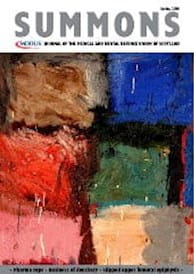JUST THE MENTION of a name can be enough to make the heart either skip with delight or sink with despair. Think of Tortora, or Kumar and Clark, and the pulsing hearts of undergraduates old and new. But even in the most authoritative textbooks there comes a point where the scientific ‘knowns’ give way to ‘unknowns’ and the authors must insert a note: “the mechanisms of this process,” they admit, “are not yet fully understood”.
Stem cell scientists, too, are open about the ‘known unknowns’ of their field. This is perhaps most notable when they take the extra step of going outside the laboratory to communicate with members of the general public. The Scottish Stem Cell Network is one example of a research community that organises gatherings for experts and also schedules open meetings at the same events to bring together leading scientists and local people.
This is a good thing to do. Many people are intrigued by the new research being reported in the media. As patients, they may wish to know what therapeutic possibilities could become available to them – the realistic hope rather than the tendency for ‘hype’. As citizens, they may be unsure about the use of human tissues in research. Some are satisfied that the blastocyst, as a very early division of cells and source of human embryonic stem cells, is entirely that: a ball of cells. Others consider its status to be ethically different for reasons to do with the nature of our species.
Regarding ‘known unknowns’, one of these is whether regenerative therapy could pass on abnormalities. Could regenerated tissue used in transplants become cancerous? Is there a risk of transmitting viruses or other pathogens from stem cell grafts? Even less discernible are the ‘unknown unknowns’ – the unintended and unanticipated consequences of this rapidly developing branch of biomedical science.
Images of pulsing cardiomyocytes grown in the laboratory convey dramatic possibilities
To help promote public understanding, the Research Councils UK partnership has produced an exhibition for display at events around the country entitled ‘Stem cell science: hope not hype’. Bringing heads together among scientists and the public, the RCUK is eager to share information both about the science and the regulatory framework as laid down by Parliament on behalf of society.
In 2003 the UK Stem Cell Bank was set up to ensure all research is conducted using only the human cell lines that it supplies to teams working on projects meeting strict ethical and clinical criteria. This safeguards the source and consent requirements for depositing of cultures, together with the quality standards of stem cell lines that are reproducible, tested and stable.
Transplantation of stem cells has been saving lives for decades through bone marrow and umbilical cord blood therapies. Ten years have now passed since the landmark achievement of replacing the nucleus of a mammalian egg cell to propagate an embryo that became the sheep named Dolly. Then last year two separate teams succeeded in reprogramming skin cells from mice, demonstrating a more efficient method of deriving stem cells without requiring oocytes.
Today there is a growing public realisation that stem cells have capacity to regenerate all tissues of the body. Images of pulsing cardiomyocytes grown in the laboratory convey this possibility dramatically. In the future, tissues will be cultured from stem cells derived from patients so as to model disease processes. Drug toxicology is a particularly promising area in the testing of new compounds on standardised hepatocytes and other cells, thereby significantly improving clinical trials of pharmaceutical products.
Heartening stuff, and not least because of the efforts of stem cell scientists to communicate and inform. Engaging the head while avoiding the hype, this is a field that holds out hope for us indeed.
Dr Al Dowie, MDDUS Senior University Teacher in Medical Ethics, Law and Risk
This page was correct at the time of publication. Any guidance is intended as general guidance for members only. If you are a member and need specific advice relating to your own circumstances, please contact one of our advisers.
Read more from this issue of Insight

Save this article
Save this article to a list of favourite articles which members can access in their account.
Save to library